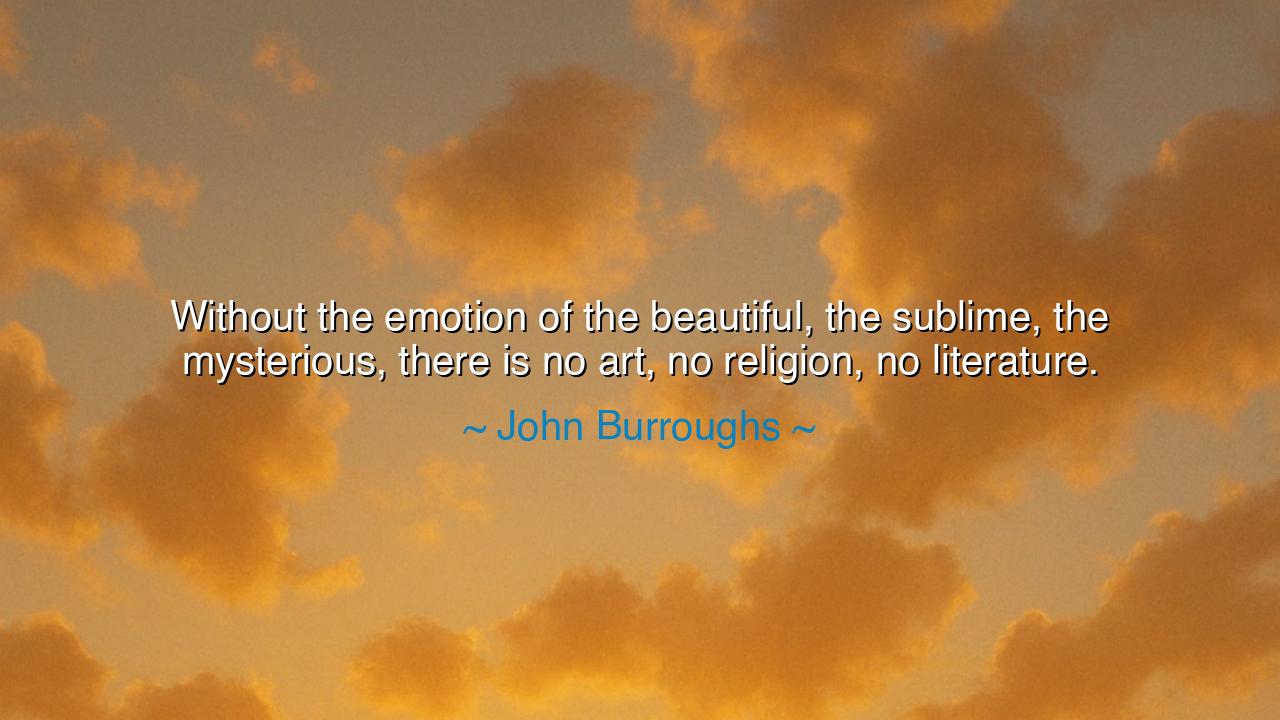
Without the emotion of the beautiful, the sublime, the
Without the emotion of the beautiful, the sublime, the mysterious, there is no art, no religion, no literature.






In the vast expanse of human expression, where the heart yearns to communicate the deepest truths, there is a force that transcends mere words and actions: the emotion of the beautiful, the sublime, and the mysterious. John Burroughs, in his eloquent wisdom, reminds us that without these emotions, the very foundations of art, religion, and literature would crumble into dust. His words, though simple, speak to the heart of what it means to be human—the innate need to connect with something greater, something that stirs the soul and awakens the spirit. “Without the emotion of the beautiful, the sublime, the mysterious, there is no art, no religion, no literature.” These words are a call to recognize the essential role of emotion in the creation of meaning and the pursuit of truth.
To understand Burroughs’ meaning, we must first look at the power of emotion itself, for it is through our emotions that we experience the world most deeply. The beautiful stirs within us a sense of awe, as we gaze upon the majestic sunset or hear a song that resonates with our deepest yearnings. The sublime takes us beyond the earthly and touches the infinite, like the feeling one gets when standing at the edge of a vast, unknown ocean, feeling the pull of something beyond oneself. The mysterious speaks to our curiosity, to that part of our being that seeks to understand the unknown, to reach for answers that seem just out of our grasp. It is these emotions that drive us to create, to search, and to explore.
In the ancient world, Greek philosophy was deeply concerned with the role of emotion in the human experience. Plato and Aristotle both saw beauty and truth as intertwined, each one capable of inspiring profound emotional responses in the soul. Plato believed that beauty was a reflection of divine truth, and that through experiencing beauty in art, nature, and even human relationships, we could glimpse a higher reality. Similarly, Aristotle in his work on poetics understood that emotion—whether through the tragic or the beautiful—was the heart of great literature and drama. He saw that the emotions stirred by art and literature had the power to purify and elevate the soul, guiding the individual toward greater wisdom and virtue.
Consider the sublime power of religious experience in history, where the emotional connection to the divine has been a driving force in shaping cultures and societies. The great cathedrals of Europe, the towering pyramids of Egypt, and the sacred shrines of India are all monuments to the emotion of the beautiful. These sacred spaces were not built merely for their architectural ingenuity but to evoke deep spiritual feelings in those who entered them. The emotion of the sublime in religious art, music, and ritual is not merely a reflection of human creativity but a powerful invocation of the divine. In this sense, religion is born not from abstract ideas alone, but from the emotional connection to the mystery and the sacred, that which cannot be fully understood but must be felt deeply.
In literature, too, we find the emotion of the mysterious at the heart of every great story. The epic journeys of Homer’s Odysseus, the search for truth in Dante’s Divine Comedy, and the timeless quest for love in Shakespeare’s works all carry within them a deep emotional current that connects us to the ancient and the eternal. It is not just the plot of these stories that moves us, but the emotions they stir—the sense of wonder, fear, love, and loss—that make them not just tales, but living experiences that resonate across time and space. Burroughs understood that the true power of literature lies in its ability to touch the heart, to stir the soul, and to make us confront the mysteries of existence.
This brings us to the heart of Burroughs’ wisdom: without emotion, the things we call art, religion, and literature are reduced to mere mechanical forms—empty vessels that lack the spark of the divine. Emotion is what gives these forms life. Art without emotion is just decoration, religion without emotion is ritual, and literature without emotion is simply words on a page. It is the emotional response that awakens us, that transforms these forms into something sacred, something worth living for. In a world increasingly consumed by logic, reason, and materialism, it is easy to forget the power of emotion, but it is through emotion that we connect with the soul of humanity, the deepest truths that transcend our individual experiences.
The lesson we take from Burroughs’ words is clear: we must not forsake the emotional side of life, for it is through the beautiful, the sublime, and the mysterious that we come to understand the full richness of our existence. In our own lives, let us seek out moments of beauty—whether in nature, art, or the relationships we cherish—and allow ourselves to feel deeply. Let us not be afraid to embrace the mysteries of life, for it is through these mysteries that we grow. Whether through creating, experiencing, or reflecting, let us allow the emotions of the beautiful, the sublime, and the mysterious to guide us toward a fuller, more meaningful life, one that resonates with the eternal truths that have moved humanity for millennia.
In doing so, we not only enrich our own lives but contribute to the collective soul of humanity, ensuring that the beauty, sublimity, and mystery of life are never lost but continue to inspire generations to come.






AAdministratorAdministrator
Welcome, honored guests. Please leave a comment, we will respond soon